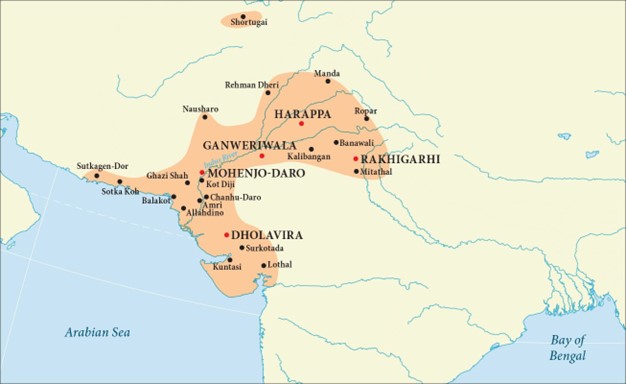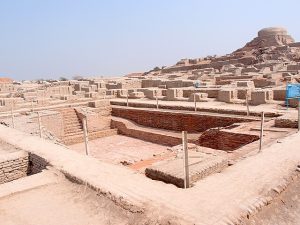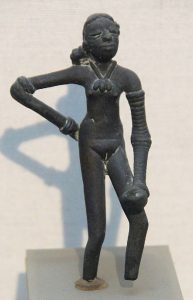16 The Indus Valley Civilizations
The Emergence of the Indus Valley Civilization
The Indus Valley Civilization (c. 2800 BCE – 1800 BCE) flourished in the fertile valley of the Indus River, which flows from the Himalayas to the Indian Ocean. The region’s rich soil and favorable climate supported population growth and the development of a sophisticated urban civilization. Evidence suggests that people in the region domesticated plants and animals around 7000 BCE, adopting techniques from the Near East or developing them independently. By 5000 BCE, they were in contact with Egyptian and Sumerian civilizations. The Indus Valley people cultivated wheat, barley, bananas, and cotton, and raised cattle and sheep.

Urbanization and City-States in the Indus Valley Civilization
Around 2800 BCE, the Indus Valley Civilization entered a new phase of growth, marked by the emergence of numerous urban centers. The largest cities, Harappa and Mohenjo-Daro, were joined by other major urban centers like Dholavira, Ganeriwala, and Rakhigarhi, as well as over 1,000 smaller cities and towns scattered across the valley. By 2000 BCE, this civilization had reached its peak, with a vast network of urban centers, each with its own unique character, but sharing a common cultural and architectural heritage. These cities may have functioned as independent city-states or been part of a larger, more complex political system.
Link to Learning
There is much to explore at the sites of Harappa and Mohenjo-Daro. Take a look at these walkthrough slideshows on Harappa (https://openstax.org/l/77harappa) and Mohenjo-Daro (https://openstax.org/l/ 77mohenjo-daro) to better understand how these cities were organized and what they look like today.
City Structure and Architecture
The cities of the Indus Valley Civilization were divided into two sections: a lower residential area and an upper citadel. The citadel featured monumental ceremonial centers, such as the large hall supported by mud-brick pilasters at Mohenjo-Daro, as well as public baths, like the large tank at Mohenjo-Daro, and granaries for grain storage. Multistory residences built around open courtyards suggest that ritual specialists or priests lived and performed religious functions in the citadels. In contrast, the residential quarters were characterized by houses with 4-6 rooms built around a central courtyard, wells providing running water to bathrooms, and larger homes with up to 30 rooms and devices attached to roofs to pump wind for cooling.

The Ancient Indus Valley Civilization was a complex society with a well-organized economy and social structure. The majority of the population, approximately 80%, were farmers who cultivated crops such as wheat, barley, and cotton. They lived in rural areas and relied on the fertile soil and sophisticated irrigation systems to sustain their agriculture. In contrast, the cities were hubs of economic activity, home to artisans, merchants, and the ruling elite. Artisans specialized in crafts such as pottery, weaving, and metalwork, producing goods for both domestic consumption and trade. Merchants played a crucial role in facilitating trade connections with neighboring regions, including the Near East and Egypt. The ruling elite, comprising of rulers and administrators, oversaw the functioning of the cities and the economy. They were responsible for managing the extensive granaries, which stored surplus grain and other agricultural produce. This surplus was used to feed the urban population, including artisans, merchants, and other non-agricultural workers.
Link to Learning
Some of the most intriguing evidence at the large Indus valley civilization sites indicates the residents had sophisticated knowledge of water engineering and built citywide drainage systems (https://openstax.org/l/ 77IndusDrainage) with covers for servicing. Evidence was found of indoor toilets that connected to this drainage network (https://openstax.org/l/77DrainageNet) that ran throughout the city.
In the Ancient Indus Valley Civilization, gender roles were relatively egalitarian. Women played a significant role in the economy, participating in agriculture, trade, and commerce. They also had access to education and could own property. The discovery of female figurines and seals suggests that women may have held important positions in religious and ceremonial contexts. However, men dominated the ruling elite and held positions of power in the cities. They were also responsible for managing trade connections and overseeing the economy. Despite this, the civilization’s emphasis on cooperation and mutual support suggests that gender roles were not rigidly defined, and individuals had some flexibility in their social and economic roles.
The Ancient Indus Valley Civilization’s economy was marked by significant achievements. Sophisticated irrigation systems allowed for extensive agriculture, enabling the civilization to support a large population. Extensive granaries stored surplus grain and other produce, providing a buffer against crop failures and ensuring food security. Industrial areas featured advanced crafts and manufacturing techniques, producing high-quality goods for both domestic consumption and trade. Furthermore, trade connections with neighboring regions, including the Near East and Egypt, demonstrate the civilization’s advanced understanding of economics, trade, and commerce. These achievements showcase the civilization’s ability to sustain a large and complex society, characterized by a high degree of economic sophistication and cooperation.
Trade, Writing, and Religion in the Indus Valley Civilization
The Indus Valley Civilization engaged in extensive trade with Mesopotamia, exchanging valuable commodities such as precious stones, marine shells, and bronze technology. Merchants traversed the region by sea and land, utilizing seals to identify ownership of goods. These seals featured brief inscriptions and depictions of human figures and animals, likely signifying names, titles, or occupations, and serving as familial or lineage totems. Merchants from the Indus Valley played a crucial role in exchanging goods with neighboring regions. In the absence of coinage, they utilized a common system of stone cubical weights to assess goods in commercial exchanges that required barter. This system of weights allowed for standardized measurements, facilitating trade and ensuring fairness in transactions. The use of stone weights also suggests a high degree of economic sophistication and cooperation among merchants and traders.
The cities of the Indus Valley likely employed these stone weights to assess taxes in kind, which were collected for their granaries. This system of taxation would have enabled the ruling elite to manage the surplus grain and other produce, ensuring food security and supporting the urban population. The use of stone weights in taxation also highlights the civilization’s advanced understanding of economics and administration, demonstrating their ability to manage complex systems and maintain social stability.
Although the Indus Valley people developed a unique writing system, its script remains undeciphered. Nevertheless, the civilization’s distinctive religious and cultural practices are evident in its art and architecture. Clay figurines depicting deities, such as a goddess bearing resemblance to the Hindu goddess Durga, and seals showcasing a horned three-faced figure akin to the Hindu deity Shiva, suggest a complex spiritual framework. The Indus Valley people believed in an afterlife, as evidenced by the modest grave goods discovered in burial sites. Their artisans created exceptional sculptures in clay, stone, and bronze, including the renowned serene bearded man from Mohenjo-Daro and a diminutive bronze figure of a young woman dancing. These artistic achievements had a profound impact on neighboring cultures, influencing artisans in the upper Ganges River valley, Baluchistan, and southeastern Iran.
Core Impact Skill — Intercultural Competence
As you explore the cities of the Indus Valley, take a moment to appreciate how their society developed unique systems of governance, religious life, and cultural expression—distinct from but equally sophisticated as those of Mesopotamia or Egypt. Imagine a world where taxation was measured not in coins but in grain, carefully weighed by standardized stone tools. Visualize elite administrators managing vast granaries to feed urban populations, and artisans shaping clay, bronze, and stone into powerful symbols of identity, belief, and beauty.
Intercultural competence means recognizing that ancient societies didn’t exist to become like us. They built different systems, held different beliefs, and still contributed deeply to the shared story of humanity.
-
What can the undeciphered Indus script and its surviving symbols tell us about how we interpret a culture we cannot read?
-
How do shared visual themes—like powerful goddesses or meditative figures—help us connect religious practices across cultures, while respecting their differences?
-
What does the spread of Indus artistic styles into neighboring regions reveal about the ways cultures interact and influence one another?
By seeking to understand the Indus Valley people on their own terms, we become better at navigating a diverse world today—one where learning from others, rather than judging them, is essential. That’s the heart of intercultural competency.
The Indus Valley Cultural Experience
A shared culture emerged in the Indus Valley, characterized by a rich spiritual life that included household altars, ceremonial bathing practices, and a symbolic visual vocabulary. Skilled artisans produced exquisite jewelry, finely woven fabrics, and detailed figurines, reflecting a prosperous urban society with well-planned streets, public buildings, and luxurious homes. This emphasis on craftsmanship and trade reveals a robust economy grounded in cooperation, specialization, and shared responsibility.
Indus Valley art and material culture reveal both originality and interaction with neighboring civilizations, showing influences from Mesopotamia and possibly later Hellenistic traditions. Women appear to have played important roles in religious and social life, as suggested by figurines depicting priestesses, dancers, and class distinctions. The famous bronze “Dancing Girl” from Mohenjo-Daro—confident, poised, and self-assured—embodies the civilization’s artistic brilliance and the cultural value placed on female presence in ritual and symbolic expression. The overall picture is one of a highly organized, spiritually rich, and artistically vibrant society.
 This four-inch-tall bronze statue of a young woman was discovered at Mohenjo-Daro and is dated to circa 2300–1750 BCE.
This four-inch-tall bronze statue of a young woman was discovered at Mohenjo-Daro and is dated to circa 2300–1750 BCE.
(attribution: Copyright Rice University, OpenStax, under CC BY 4.0 license)
An Era of Decline
Around 1800 BCE, the Indus Valley Civilization began to decline, marking the end of centuries of trade with Mesopotamia. Over the next four centuries, the cities of the Indus River valley were gradually depopulated, and the civilization slowly disintegrated. The reasons behind this decline remain a mystery, with various theories attempting to explain the collapse.
One widely accepted view suggests that regional climate change played a significant role in the civilization’s downfall. Around 2000 BCE, the Indus River’s floodplain underwent a dramatic shift, resulting in dry river beds and altered water flows. Changes in the monsoon patterns may have triggered these environmental effects, leading to a scarcity of water for drinking and irrigation. Without a reliable water source, the cities would have struggled to sustain their populations. Another theory proposes that environmental degradation, caused by urbanization and population growth, rendered the land uninhabitable. Some researchers suggest that tectonic activity may have altered the course of the rivers, while others consider the possibility of epidemic diseases decimating the population.
The truth behind the collapse of the Indus Valley Civilization may never be fully known. It is likely that a combination of factors contributed to its downfall. Environmental degradation, caused by years of resource exploitation and high population density, certainly played a role. Climate change and disease may have further exacerbated these issues, weakening the civilization and making it vulnerable to attack by raiding groups like the Aryans.
By around 1500 BCE, the social and political systems of the Indus Valley Civilization had broken down, and its sophisticated culture had collapsed. The distinctive architectural styles, writing system, advanced metalworking, and artisanal crafts that characterized the civilization at its peak were abandoned. The Indus Valley Civilization had come to an end, marking the conclusion of a remarkable era in human history.
